How Can Your Store Use Data-Driven Retail Strategy in Today’s Hyper-Competitive Environment @ the NHPA Conference
Datastory, a division of E.A. Langenfeld, will be exhibiting at the NHPA Independents Conference in Dallas on August 3rd – 4th. The conference caters to independent hardware retailers taking an opportunity to learn from industry experts about the latest trends and solutions in technology. Datastory is positioned to demonstrate how retailers can optimize a data-driven retail strategy.
Visit Datastory at Booth #20 to discover how location intelligence is revolutionizing the way businesses adapt and make data-driven decisions with MapDash ™, a platform that delivers market insights – without a hefty investment!

MapDash™ is a single source of intelligence to help you make smarter location decisions. Retailers are streamlining localization strategy into one platform that blends customer insights, competition, real-time weather & events, and more. This helps to pinpoint localization for targeted marketing campaigns, merchandising, customer experiences and operations.
Retailers are utilizing this easy-to-use platform to answer questions such as:
Who Lives Near My Store(s)?
Learn more about consumers in your market to help understand their path to purchase.
Customer segment data reveals demographic insights, lifestyle habits, shopping behaviors and psychographic characteristics that influence buying decisions.
For example, a neighborhood with “Soccer Moms” may respond better to back-to-school social media promos. Analyzing local consumer data uncovers gaps or saturation in the retail mix of an area. A retailer can spot unmet consumer needs and adjust product assortment and services. MapDash can help identify the target customer profile for that area – their age, income, family status, interests etc. This allows better tailoring of products and messaging to resonate with local shoppers.

Who is Coming into My Store(s)?
Monitor Foot Traffic to see the breakdown in which customers are visiting a store (and competition!).
Foot traffic data provides insights into how many people are visiting a retail store. Foot traffic metrics can be used to compare the performance of different store locations in a chain. Stores with higher foot traffic may have better merchandising mixes. Lower-traffic stores can be analyzed to understand why.
Tracking Foot Traffic also allows retailers to measure marketing effectiveness; did that back-to-school promo drive more “Soccer Moms” into your store? Alternatively, we can track the Foot Traffic at competing stores nearby. And then we can see which customer segments are coming in – “Soccer Mom” or “Comfortable Empty Nester”!

What is the Pro Business Opportunity?
Target specific businesses near a store to develop a strategic marketing strategy.
Retailers looking to grow their B2B sales can use MapDash to target both private businesses and public entities nearby. Are there other business locations near your store that you can provide lunch & learns, discounts or delivery programs to? How can you incentivize these businesses to partner with you?
Retailers can uncover gaps in the local business mix that your products or services could fill as an ideal spot for expansion. The key is leveraging geographic data points to hone in on the most relevant or high-potential B2B targets surrounding each individual store location. This allows for tailored outreach and strategic partnerships.

How can I Achieve Localization at Scale?
Uncover consumer trends by location to optimize physical footprint, marketing, merchandising and operations across your market opportunity.
Hyper-local retailing can be simple if you are managing 1 store. But as a portfolio grows, so should a retail strategy. Advancing localization for MANY stores can be challenging, but fortunately, MapDash has an easy way to achieve this. Using a market insights tool with an overview of multi-store performance and market opportunity allows a retailer to pinpoint gaps in the marketplace, sort priority locations for specific investments, and learn more about locations without even visiting them.
Incorporating geospatial data, mapping, and location analytics into planning helps retailers make smarter, more localized decisions to drive strategy and growth.

Where Should I Open a New Store?
Quickly identify optimal locations for new stores based on demographics, competitors, traffic patterns, and other location-based factors. Expand your physical footprint into high-potential areas.
Incorporating geospatial data, mapping, and location analytics into planning helps retailers make smarter, more localized decisions to drive strategy and growth. Identify where there may be gaps in demand, tight competition, or growing markets. Simply targeting a market is not good enough when evaluating site locations for new stores; it’s vital to understand exactly which neighborhoods and shopping centers are ideal within a market.
MapDash has data available on population growth, environmental risks, traffic layers, and customer profiles that can help pinpoint these ideal locations. By leveraging MapDash, retailers make data-driven decisions on new sites, mitigating risk and maximizing store potential. The spatial insights derived help expand into optimal areas.

We hope you’ll visit the Datastory team at Booth # 20 to visualize the power of MapDash for yourself!